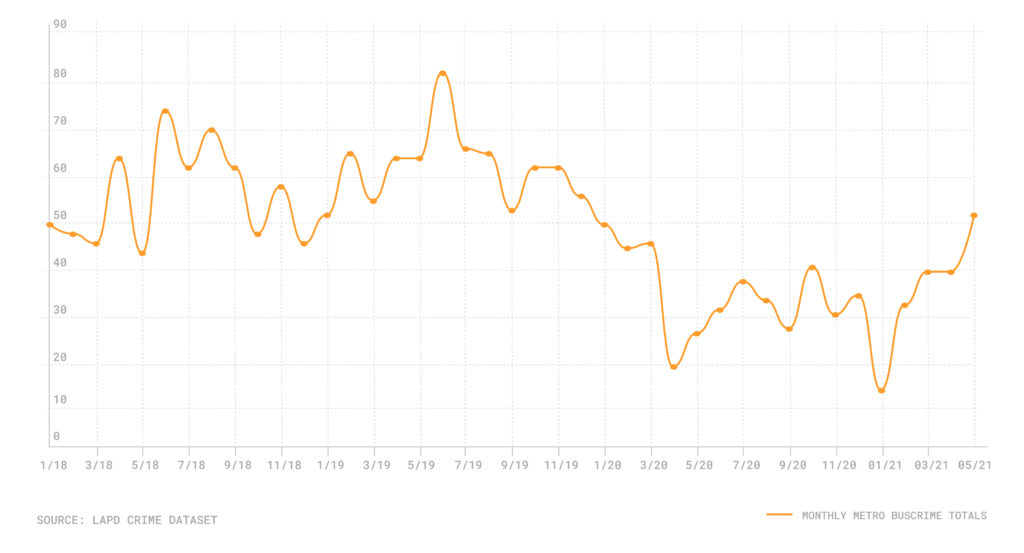As bus ridership climbs again, so does crime

During the pandemic, ridership on the Los Angeles public transit system plummeted. Now, as vaccination rates increase and the economy reopens, more people are getting back on Metro trains and buses.
But as ridership is rising again, so is crime, and assaults in particular. In May, there were 53 criminal incidents on Metro buses, according to Los Angeles Police Department data. That is the highest monthly total since the start of the pandemic, and an increase of 12 crimes from the previous month.
Number of monthly LAPD crime reports on Metro buses, Jan. 2018-May 2021

Buses account for 79.1% of public transit passengers in Los Angeles, according to Metro data. Before the pandemic, the Metro system carried approximately 1.2 million riders each day, said Metro Communications Manager Dave Sotero. The vast majority rode without incident.
However, there have been ongoing concerns about safety. In 2019 the LAPD recorded 748 criminal incidents on Metro buses. The year prior there were 684. (The LAPD compiles crime statistics for Metro rail lines and buses separately.)
Aggravated assaults on buses have risen precipitously this year. The 34 recorded from Jan.1-May 31 marks an 88.9% jump from the same time in 2020, and a 209.1% jump from the 11 tallied during a similar period in 2019.
The cases include an incident on April 2, when a 28-year-old woman riding a G-line bus in Vermont Vista was maced by a stranger. Another call involved a bus in University Park on May 24. There, a 32-year-old man was held at gunpoint by a passenger.
On the other hand, thefts on buses are decreasing. There were 18 reports of theft reported in the first five months of 2021, compared to 86 during the same period in 2019.
Overall Metro traffic is slowly rebounding. According to agency data, there were an average of 511,025 daily riders on the system in May (the vast majority were on Metro buses, with about 21,700 riders on affiliated routes run by entities Metro contracts with). That is a 58% increase from the 323,231 daily average riders May 2020.
By comparison, the 53 criminal incidents this May is an 89.3% increase over the 28 in the same month in 2020.
Bouncing back
Metro compressed its services and hours during the early months of the pandemic, including cutting most late-night bus routes. Now, the agency is reinstating trips on select lines as it works to have all 122 bus routes back to normal by September. On June 27, new schedules began for major portals in neighborhoods such as Downtown, Westlake and Los Feliz.
“We do anticipate that it is going to take a while for ridership to go back to pre-pandemic levels of 1.2 million riders per day,” Sotero said.
Most crime on the system occurs from 9 a.m.-5 p.m. during the work week. Metro contracts with law enforcement agencies, including the LAPD and the Los Angeles Sheriff’s Department, to patrol the system. According to Sotero, teams of officers ride bus and rail lines on a daily basis and patrol stations.
The Metro board of directors recently approved funding for alternative patrols to help people experiencing homelessness who seek shelter on public transit. The agency’s Public Safety Advisory Committee, which held its first meeting in April, is working with community leaders in the effort to scale back armed law enforcement on transit.
“Our customers and the public have told us they wanted us to pursue a community-based approach to public safety,” Sotero said. “This committee is going to help us move in that direction.”
How we did it: We examined LAPD data on crimes involving Metro buses from Jan. 1, 2018-May 31, 2021. For neighborhood boundaries, we rely on the borders defined by the Los Angeles Times. Learn more about our data here.
LAPD data only reflect crimes that are reported to the department, not how many crimes actually occurred. In making our calculations, we rely on the data the LAPD makes publicly available. On occasion, the LAPD may update past crime reports with new information, or recategorize past reports. Those revised reports do not always automatically become part of the public database.






